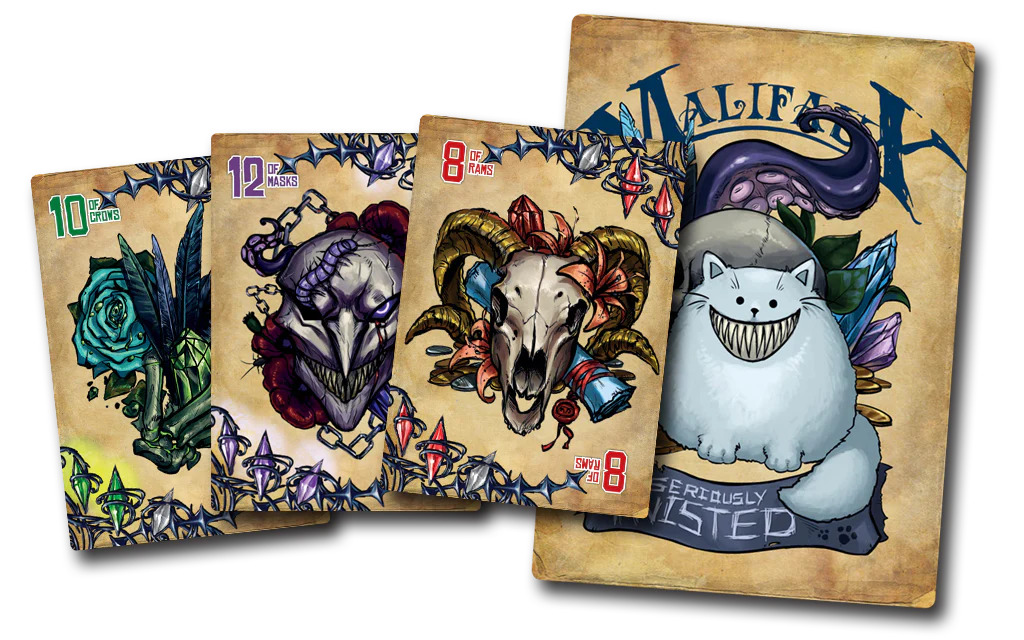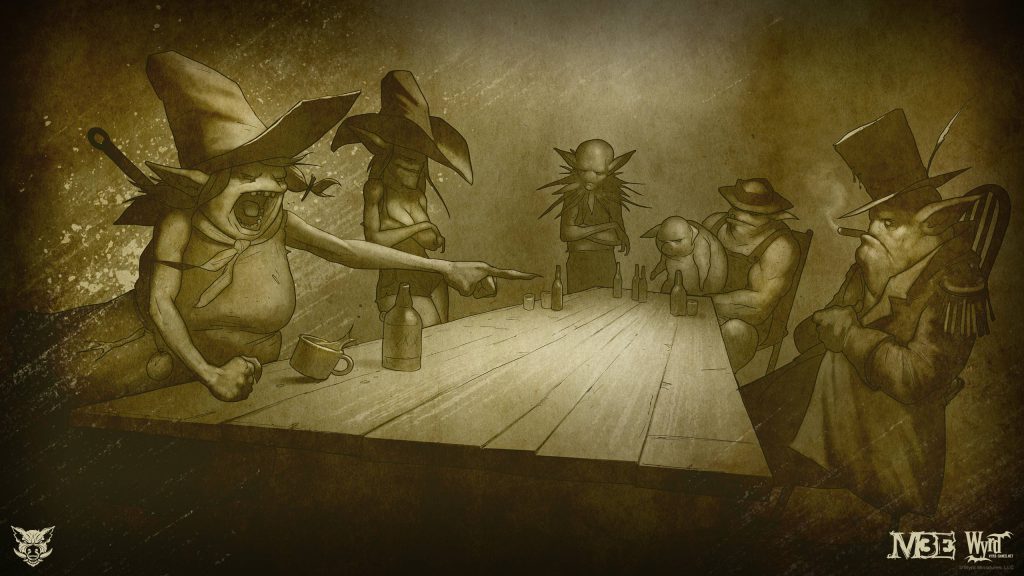Hello again, Mali-folks! As I write this, we’re expecting an errata dump as soon as next week, and you’d better believe I’ll be on that like stink on a Mindless Zombie. But in the meantime, I’d like to continue my Malifaux 102 series with an article on a topic essential to both Malifaux and wargaming generally: variance!
Before we dive into the meat of the article, I want to set some parameters here. I am not a statistician and this is not a Hammer of Math-style article. Instead, I’m speaking more generally about principles of design and how they play out on the table. That means this article is inherently going to be more abstract than most. I am also talking about an incredibly complicated topic that, in my opinion, suffers from a great deal of conceptual vagueness. People discuss variance all the time, but too often these conversations end with both sides talking past each other.
I am therefore going to define variance up-front so we are all talking about the same thing. This definition is not the only definition, or even the most correct definition; it is the definition that I think is the most useful when talking about variance specifically in the field of wargaming. Throughout this article, when I refer to “variance,” what I mean is the range of possible outcomes when you attempt to execute a plan. Variance exists on the level of individual actions, model activations, and entire sequences of activations (or even entire turns). The broader the variance, the more different outcomes there can be; the narrower the variance, the fewer outcomes there can be. As a corollary, a plan with a higher degree of variance has a higher chance of failure – because of all the possible outcomes, some are failures.
Finally, a disclaimer: this article inherently requires a greater or lesser degree of abstraction and simplification. I am not going to write “of course, this is a simplification” over and over again, so whenever it feels like I’m simplifying things, imagine I said that and don’t get mad.
Ready? Let’s jump in!
Where Does Variance Come From?
Every game has some degree of variance; if it didn’t, you’d be playing Candyland (which is not actually a game! It’s just a pastime!!!). Variance is why we play the game; otherwise, you could just compare ELO (or seed, or MMR, or whatever your game of choice uses) and the better number would win. Every game’s source of variance is different.
In Warhammer (and most tabletop games), variance comes from the attack resolution mechanic: you have to throw the dice, and they don’t come up with the same numbers showing every time. This is an important design principle to keep in mind: you can always do the move you want to do, but you don’t know precisely what effect the move will have.
In Magic: the Gathering (and many other CCGs) variance comes instead from the deck mechanic. You don’t always have the same cards, and you don’t know what order you’ll get your cards in. You can’t always do the move you want to do, but when you do the move, you usually know exactly what effect it will have (barring coin flip cards and dice-rolling un-cards, of course).
When it comes to variance, Malifaux behaves mostly like a wargame, though not entirely. The hand mechanic both reduces and increases variance: it reduces it by allowing you to cheat, replacing your randomly-generated number with a fixed one; but it increases it, because you never know what cards you’re going to draw. Overall, the existence of the Fate Hand and the cheating mechanic reduces variance, and managing that reduction is one of the most important player skills you can have in Malifaux.
Malifaux actually has three sources of variance, and all of them are important.
First: as previously mentioned, whenever you make an attack or damage flip or take an action with a TN (and in a few other circumstances) you flip a card. The value you flip determines whether your attack hits or misses, or whether your action fails or succeeds. It can also determine how well an action works: how much damage an attack deals, how much healing a support action provides, and so on.

Second is the trigger mechanic. Triggers are a core part of Malifaux, and some models have the majority of their power budgeted into one or two key triggers. There are some actions where the trigger is the whole point. Many powerful actions also have multiple triggers, and you can only declare one. Which suits you flip sometimes matter even more than which values. This source of variance is mostly independent from the first one (since you can fail with the right suit or succeed with the wrong one), but is managed in overlapping ways; cheating a card can fix your suit as well as your value, but there are also other ways to get suits.
Third is the alternating activation system. This may not be intuitive, but it’s actually a key source of variance for Malifaux. The key to the alternating activation system is that whenever you do something, your opponent immediately gets to react. That naturally increases variance for any plan that takes longer to execute than a single activation. Whatever you’re trying to do, your opponent has the chance to disrupt… which means that you can’t necessarily count on your plan working out the way you wanted it to.
Why is Variance Important?
So now we know what variance is and where it comes from. Why does it matter?
Managing variance is a key part of game design. That’s because variance is incredible important for controlling one of the most important stats any game can have: the percentage of time the better player wins.
Imagine a sliding scale. At one end, the better player wins exactly 50% of the time; their skill has no impact whatsoever on the game’s outcome, which is basically a coin flip (in a game of this sort, I would argue that it’s not actually possible to be skilled, and so you cannot be “better”… imagine it’s like 50.000001% or something). Obviously, this game isn’t that much fun, at least if you care about winning or getting better.
At the other end, the better player wins 100% of the time. That may seem briefly tempting – especially if you’re the kind of person who works hard to be good at games – but really, we’re getting into Candyland territory again. Why bother playing? Just compare numbers.

There’s an ideal number, and a lot of debate about what it is. I don’t want to wade into that discussion here, exactly, except to note that there is both upside and downside risk. If your Percent Better Player Win (PBPW?) is too high, your game will repel new players; who wants to play a game where they have to lose 100 times before they can win once? If your PBPW is too low, on the other hand, it feels frustrating for experienced players. No matter how much time they invest in the game, sometimes Some Bullshit just crops up and they lose. (There are, of course, beer and pretzels games where you don’t really care if you win or lose, but most broad-appeal wargames at least have a competitive mode).
One of those extremes is terrible for new player acquisition; the other is terrible for player retention. You need both to keep a game healthy and vibrant.
So where does variance come in? Simply put, the more variance in your game, the more often the “less skilled” player can win. The explanation is simple and, hopefully, intuitive: in any given game, the “more skilled” player is more often going to make the correct choices. The more often those choices fail, the worse they’ll do. The less skilled player’s plans can fail, too, but if those plans were incorrect – if they were making a mistake anyways – that failure doesn’t change the expected outcome of the game. To put it in Warhammer terms, if you’re choosing to charge a block of Custodes with your Flayed Ones when the Flayed Ones really should be sitting their butts on an objective, the charge roll failing is not going to hurt your chances of winning the game. In fact, it might help!
Mark Rosewater, the head designer for Magic: the Gathering, has discussed this concept, often in the context of “mana screw.” Being mana screwed feels really bad, but mana screw (and mana flood, its cursed cousin) are both reasons why a more skilled player might lose to a less skilled one – and that type of thing keeps the game interesting, and keeps the less skilled player from getting fed up.
How to Manage Variance
There’s a flip side to this: the more you can minimize variance, the more consistently you’ll be able to win. If you’re good at Malifaux, really really good, then one way to ensure that you win a lot of games is to reduce the impact luck can have on your plans. There are three primary ways to accomplish this:
Card Draw
Card draw is one of the most powerful abilities in Malifaux. Drawing cards gives you more cheats. More cheats means you can be sure to win more duels.
Note here that a card “cycle” (draw a card, then discard a card, or do those two in the opposite order) is almost as good as a draw. Imagine your hand is a 2, a 4, a 7, a, 10, and a 12. There are two cards in that hand that you can probably cheat to win a duel, one card that you can cheat to pass a TN (but probably not win a duel), and two cards you can’t do much with. For most purposes, you have a three card hand. Now imagine you hit a Drain Magic trigger and get to cycle a card. You draw an 11 and discard your 2. Now you have another card you can win duels with! You effectively just drew a card!
Card draw also helps you hit your triggers, though somewhat less directly, since you can’t guarantee that you’ll draw a card high enough to win a duel that is also the correct suit.
Overall, drawing more cards than your opponent is the number one way to minimize variance, and there’s a reason why many of the most broken crews of the past couple of years also featured tons of incidental card draw.

Activation Control
This one is more subtle, but arguably even more important. Activation control means a couple of things, but broadly it means “getting the last activation.” Last activation is huge for two reasons: first, because if you are activating last on turn one, you can do a powerful alpha strike that your opponent can’t react to (because they have no models left to activate); second, because if you activate last you get the last chance to both score your schemes and disrupt your opponent’s scoring. Because the vast majority of all Malifaux points are scored during the end phase, having the last activation will often allow you to take points off the board for your opponent.
Chain activating is another way to do this: if you get two activations in a row, then you get to both set up a power play and carry it out without your opponent getting to do anything about it. Abilities like Accomplice and Companion let you extend yourself, secure in the knowledge that you can’t be punished because your opponent can’t even act before you drop the hammer.
The easiest way to achieve activation control is through Pass Token generation, and it’s noteworthy that models that generate Pass Tokens are often staples that are hired out of keyword with frequency. Pass Token generation not only guarantees you last activation, but it also gives you a bonus to initiative on your next turn – increasing the chance that you can act last on one turn and first on the next, letting you activate a key model twice in a row. Not much can survive two Hinamatsu activations back-to-back!
I’ll pause to note here that most Leverage models not named Bill Algren often aren’t hired out of keyword, and that’s because Leverage is a bit of a special case; because it doesn’t start to accrue tokens until your opponent has already scored, it doesn’t help deny scoring as much as you might think, and it never activates turn 1, which is when pass tokens are the most powerful.
Careful Planning
Still, not every crew draws tons of cards, and most crews don’t generate Pass Tokens. So what are you to do? Give up? Cry?
Neither! (Well, you can cry sometimes.) The important thing to do is to recognize what resources you have, and spend them appropriately. For example, if you don’t have card draw, you have up to 6 cheats in a turn. Let’s say you have 4 cheats, either because your cards are bad or because your opponent is pressuring your hand. Think at the start of the turn: which 4 actions absolutely must succeed? Examples of actions that often have to succeed for your plan to work include Leap, Ride/Fly With Me, “Drop the Pianos!” and The Race Is On!

Next, think of actions that make other actions more like to succeed. For example, Cornelius Basse’s Caught in Quicksand is a Stat 7 against Mv and applies Injured to the target, making all of your attacks more likely to hit. If your hand can’t support a full battery of attacks, consider Quicksanding a key target once or twice, both to serve them up to Jonathan Reichert or the Sand Worm on a silver platter and to stack enough Injured on them that you don’t need to cheat to reliably hit.
You can also think of actions that don’t require a duel to succeed. Is your Iron Skeeter in position to attack a valuable model, but you don’t have the cards necessary to guarantee that its Stat 5 attack goes through? Why not just Walk and Interact instead? You don’t have to flip any cards, and depending on your Schemes that can just lock in a point. Sure, you won’t kill that model, but points are how you win the game, and you’ll have another shot at it later on (with a better hand).
In terms of activation control, there’s one key heuristic that almost always works: kill an unactivated model! If you do that, your opponent loses an activation, but does not gain a Pass Token. If you go first and kill one unactivated model and your opponent kills none, then you get last activation that turn. If you kill two, you get the last two activations. And so on.
This also affects the way your plan changes on the fly. Say you’re setting up your Metal Golem to kill a juicy Dead Doxy. But then that Doxy activates. Well, maybe you don’t need to activate your Golem right away. That Doxy isn’t going anywhere, and she already activated, so you won’t get activation control for killing her. Maybe instead you activate Neil Henry and try to smash that pesky little Copycat Killer before it activates, thus denying Seamus last activation.
Finally, understand where variance is unavoidable, and think about how that might affect your plans. Say you’ve got Seamus juiced up and you’re preparing to take a shot. But your Tiri-playing opponent has clustered around their Ancient Construct, so no matter who you want to shoot, you’re hitting the robot. Sure, you have a 13 in your hand… but oppo has been drawing cards all turn and it’s reasonable to bet that they have one, too. The best you can do in that situation is tie, which means even with Focus, you’re still netting to a negative flip for damage (and won’t be able to cheat). Can your plan survive you shooting the robot for 1 or 3 damage rather than 5? If not, can you plan to do something else? Maybe use a Lure first…

Oh, and don’t forget that Jokers exist. If you haven’t seen them yet, you can’t exactly plan for them. You can sometimes deal with a Joker in your opponent’s hand, if your stat is higher than theirs and you have a 13 to cheat, but if they flip it all bets are off. Try to roll with the punches.
Putting It All Together
So what did we learn today? This article meandered a bit, so I’ll try to set things out as clearly as possible:
- Variance is why more-skilled players don’t win every times. Even the best-laid plans gang aft agley, especially where Jokers are involved.
- An important skill to leveling up your play is minimizing the impact of variance on your plans.
- The two best ways to do that are to draw cards and generate pass tokens. Crews that do either or both (coughYouko2cough) tend to be the best in the game and the most easily broken.
- Even if you can’t draw tons of cards or generate pass tokens, you can minimize variance by identifying key actions you need to cheat, killing unactivated models for activation control, and taking actions that make your other actions more likely to succeed.
- When variance is unavoidable, don’t go all-in hoping for the best; instead, figure out if your turn still looks good if the worst happens, and if it doesn’t, recalculate your plans.
I hope this was helpful! I promise future Malifaux 102 articles will be a bit more concrete. That’s all for now, but stay tuned, because we should be getting a new errata any day now, and I’ll drop my hot take as soon as that happens.
Have any questions or feedback? Drop us a note in the comments below or email us at contact@goonhammer.com.


